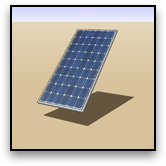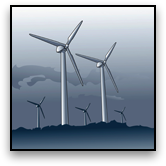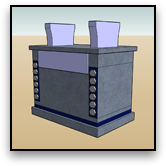Monothermal: Greener than 'Green'
'GREEN' TECHNOLOGY
There is so much talk about what's best for the environment these days.The ultimate 'green' technology for producing energy would definitely be one that produces zero emissions, thereby contributing as little as possible to any negative effects of climate change. Wind power falls into this category. Solar does as well.
But solar power suffers from the obvious drawback of being useless during nighttime hours and ineffective on overcast days. The cost of the initial outlay for panels is also substantial. Wind turbines sit idle unless sufficient airflow occurs naturally in the wind corridor. They’re also vulnerable to damage from lightning strikes and some groups have criticized them for their effect on avian populations. And on a commercial level, both solar and wind require significant resource dedication in the form of land use, while failing to return effective amounts of raw energy relative to that use when compared to non-renewable sources. Hydroelectric power, another quasi-green energy source, requires the damming of rivers and other water bodies.
DRAWBACKS OF EXISTING 'GREEN' TECHNOLOGY

SOLAR

WIND

HYDRO

FUEL CELLS
SOLAR — Expensive to produce panels. Energy return not necessarily efficient relative to area occupied by panels.
WIND — Expensive to build and site. Energy return negligible relative to amount of land area needed per kilowatt. Mechanical failures can often be explosive and catastrophic, endangering both infrastructure and lives.
FUEL CELLS — Require continuous replenishment of the reactants consumed, i.e. their fuel supply. Concerns about leaked hydrogen causing damage to the ozone layer as well as the potentially explosive nature of stored hydrogen are other negative factors.
HYDRO — Damage to native ecosystem. Negative effect on local fish populations and river navigability.
WIND — Expensive to build and site. Energy return negligible relative to amount of land area needed per kilowatt. Mechanical failures can often be explosive and catastrophic, endangering both infrastructure and lives.
FUEL CELLS — Require continuous replenishment of the reactants consumed, i.e. their fuel supply. Concerns about leaked hydrogen causing damage to the ozone layer as well as the potentially explosive nature of stored hydrogen are other negative factors.
HYDRO — Damage to native ecosystem. Negative effect on local fish populations and river navigability.
Says Guenther, “Fuel cells are cumbersome and potentially dangerous. Wind farms are expensive and require an abundance of space. Solar panels are also expensive and need to be sited toward the sun. By contrast, the Monothermal needs heat, not light. Monothermal panels can even be ‘stacked’ to increase their efficiency – often significantly.”
The Monothermal works in any environment when the effective ambient temperature falls within the viable range. Furthermore, the constituent elements of the Monothermal (copper, phosphorus, chromic oxide, aluminum magnesium) become inert and thus safe for the environment when combined to create the final Monothermal laminate.
Bottom line? The Monothermal produces no known emissions and has none of the drawbacks of competing 'green' technologies.
The Monothermal works in any environment when the effective ambient temperature falls within the viable range. Furthermore, the constituent elements of the Monothermal (copper, phosphorus, chromic oxide, aluminum magnesium) become inert and thus safe for the environment when combined to create the final Monothermal laminate.
Bottom line? The Monothermal produces no known emissions and has none of the drawbacks of competing 'green' technologies.




